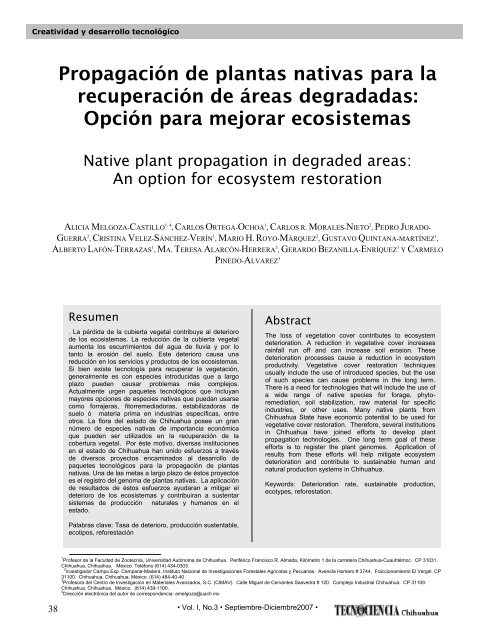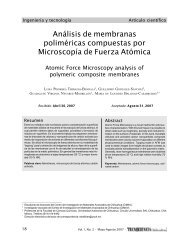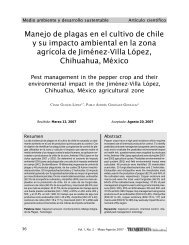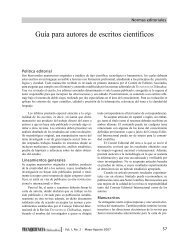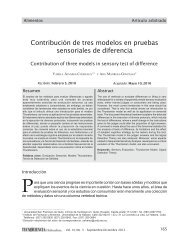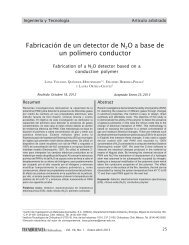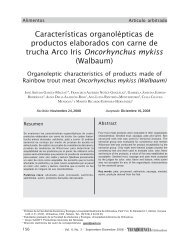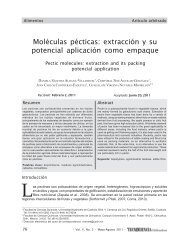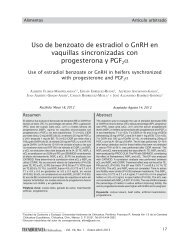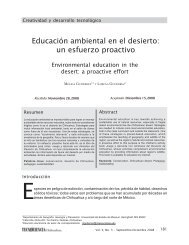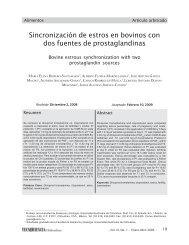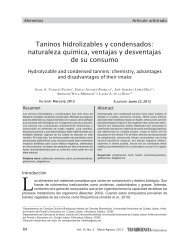Propagación de plantas nativas para la recuperación de áreas ...
Propagación de plantas nativas para la recuperación de áreas ...
Propagación de plantas nativas para la recuperación de áreas ...
You also want an ePaper? Increase the reach of your titles
YUMPU automatically turns print PDFs into web optimized ePapers that Google loves.
Creatividad ALICIA MELGOZA-CASTILLO, y <strong>de</strong>sarrollo CARLOS tecnológico<br />
ORTEGA-OCHOA, CARLOS R. MORALES-NIETO, PEDRO JURADO-GUERRA, CRISTINA VELEZ-SÁNCHEZ-VERÍN, MARIO H. ROYO-MÁRQUEZ,<br />
GUSTAVO QUINTANA-MARTÍNEZ, ALBERTO LAFÓN-TERRAZAS, MA. TERESA ALARCÓN-HERRERA, GERARDO BEZANILLA-ENRÍQUEZ Y CARMELO PINEDO-ALVAREZ: <strong>Propagación</strong><br />
<strong>de</strong> <strong>p<strong>la</strong>ntas</strong> <strong>nativas</strong> <strong>para</strong> <strong>la</strong> <strong>recuperación</strong> <strong>de</strong> <strong>áreas</strong> <strong>de</strong>gradadas: opción <strong>para</strong> mejorar ecosistemas<br />
38<br />
<strong>Propagación</strong> <strong>de</strong> <strong>p<strong>la</strong>ntas</strong> <strong>nativas</strong> <strong>para</strong> <strong>la</strong><br />
<strong>recuperación</strong> <strong>de</strong> <strong>áreas</strong> <strong>de</strong>gradadas:<br />
Opción <strong>para</strong> mejorar ecosistemas<br />
Native p<strong>la</strong>nt propagation in <strong>de</strong>gra<strong>de</strong>d areas:<br />
An option for ecosystem restoration<br />
ALICIA MELGOZA-CASTILLO 1, 4 , CARLOS ORTEGA-OCHOA 1 , CARLOS R. MORALES-NIETO 2 , PEDRO JURADO-<br />
GUERRA 2 , CRISTINA VELEZ-SÁNCHEZ-VERÍN 1 , MARIO H. ROYO-MÁRQUEZ 2 , GUSTAVO QUINTANA-MARTÍNEZ 1 ,<br />
ALBERTO LAFÓN-TERRAZAS 1 , MA. TERESA ALARCÓN-HERRERA 3 , GERARDO BEZANILLA-ENRÍQUEZ 1 Y CARMELO<br />
Resumen<br />
. La pérdida <strong>de</strong> <strong>la</strong> cubierta vegetal contribuye al <strong>de</strong>terioro<br />
<strong>de</strong> los ecosistemas. La reducción <strong>de</strong> <strong>la</strong> cubierta vegetal<br />
aumenta los escurrimientos <strong>de</strong>l agua <strong>de</strong> lluvia y por lo<br />
tanto <strong>la</strong> erosión <strong>de</strong>l suelo. Este <strong>de</strong>terioro causa una<br />
reducción en los servicios y productos <strong>de</strong> los ecosistemas.<br />
Si bien existe tecnología <strong>para</strong> recuperar <strong>la</strong> vegetación,<br />
generalmente es con especies introducidas que a <strong>la</strong>rgo<br />
p<strong>la</strong>zo pue<strong>de</strong>n causar problemas más complejos.<br />
Actualmente urgen paquetes tecnológicos que incluyan<br />
mayores opciones <strong>de</strong> especies <strong>nativas</strong> que puedan usarse<br />
como forrajeras, fitorremediadoras, estabilizadoras <strong>de</strong><br />
suelo ó materia prima en industrias específicas, entre<br />
otros. La flora <strong>de</strong>l estado <strong>de</strong> Chihuahua posee un gran<br />
número <strong>de</strong> especies <strong>nativas</strong> <strong>de</strong> importancia económica<br />
que pue<strong>de</strong>n ser utilizados en <strong>la</strong> <strong>recuperación</strong> <strong>de</strong> <strong>la</strong><br />
cobertura vegetal. Por éste motivo, diversas instituciones<br />
en el estado <strong>de</strong> Chihuahua han unido esfuerzos a través<br />
<strong>de</strong> diversos proyectos encaminados al <strong>de</strong>sarrollo <strong>de</strong><br />
paquetes tecnológicos <strong>para</strong> <strong>la</strong> propagación <strong>de</strong> <strong>p<strong>la</strong>ntas</strong><br />
<strong>nativas</strong>. Una <strong>de</strong> <strong>la</strong>s metas a <strong>la</strong>rgo p<strong>la</strong>zo <strong>de</strong> éstos proyectos<br />
es el registro <strong>de</strong>l genoma <strong>de</strong> <strong>p<strong>la</strong>ntas</strong> <strong>nativas</strong>. La aplicación<br />
<strong>de</strong> resultados <strong>de</strong> éstos esfuerzos ayudaran a mitigar el<br />
<strong>de</strong>terioro <strong>de</strong> los ecosistemas y contribuiran a sustentar<br />
sistemas <strong>de</strong> producción naturales y humanos en el<br />
estado.<br />
Pa<strong>la</strong>bras c<strong>la</strong>ve: Tasa <strong>de</strong> <strong>de</strong>terioro, producción sustentable,<br />
ecotipos, reforestación<br />
PINEDO-ALVAREZ 1<br />
Abstract<br />
1<br />
Profesor <strong>de</strong> <strong>la</strong> Facultad <strong>de</strong> Zootecnia, Universidad Autónoma <strong>de</strong> Chihuahua. Periférico Francisco R. Almada, Kilómetro 1 <strong>de</strong> <strong>la</strong> carretera Chihuahua-Cuauhtémoc. CP 31031.<br />
Chihuahua, Chihuahua. México. Teléfono (614) 434-0303.<br />
2 investigador Campo Exp. Campana-Ma<strong>de</strong>ra, Instituto Nacional <strong>de</strong> Investigaciones Forestales Agríco<strong>la</strong>s y Pecuarias. Avenida Homero # 3744. Fraccionamiento El Vergel. CP<br />
31100. Chihuahua, Chihuahua. México. (614) 484-40-40<br />
3<br />
Profesora <strong>de</strong>l Centro <strong>de</strong> Investigación en Materiales Avanzados, S.C. (CIMAV). Calle Miguel <strong>de</strong> Cervantes Saavedra # 120. Complejo Industrial Chihuahua. CP 31109.<br />
Chihuahua, Chihuahua. México. (614) 439-1100.<br />
4<br />
Dirección electrónica <strong>de</strong>l autor <strong>de</strong> correspon<strong>de</strong>ncia: amelgoza@uach.mx<br />
• Vol. I, No.3 • Septiembre-Diciembre2007 •<br />
The loss of vegetation cover contributes to ecosystem<br />
<strong>de</strong>terioration. A reduction in vegetative cover increases<br />
rainfall run off and can increase soil erosion. These<br />
<strong>de</strong>terioration processes cause a reduction in ecosystem<br />
productivity. Vegetative cover restoration techniques<br />
usually inclu<strong>de</strong> the use of introduced species, but the use<br />
of such species can cause problems in the long term.<br />
There is a need for technologies that will inclu<strong>de</strong> the use of<br />
a wi<strong>de</strong> range of native species for forage, phytoremediation,<br />
soil stabilization, raw material for specific<br />
industries, or other uses. Many native p<strong>la</strong>nts from<br />
Chihuahua State have economic potential to be used for<br />
vegetative cover restoration. Therefore, several institutions<br />
in Chihuahua have joined efforts to <strong>de</strong>velop p<strong>la</strong>nt<br />
propagation technologies. One long term goal of these<br />
efforts is to register the p<strong>la</strong>nt genomes. Application of<br />
results from these efforts will help mitigate ecosystem<br />
<strong>de</strong>terioration and contribute to sustainable human and<br />
natural production systems in Chihuahua.<br />
Keywords: Deterioration rate, sustainable production,<br />
ecotypes, reforestation.
ALICIA MELGOZA, CARLOS ORTEGA, CARLOS R. MORALES, PEDRO JURADO, CRISTINA VELEZ, MARIO H. ROYO, GUSTAVO QUINTANA, ALBERTO LAFÓN, MA. TERESA ALARCÓN,<br />
GERARDO BEZANILLA Y CARMELO PINEDO: <strong>Propagación</strong> <strong>de</strong> <strong>p<strong>la</strong>ntas</strong> <strong>nativas</strong> <strong>para</strong> <strong>la</strong> <strong>recuperación</strong> <strong>de</strong><br />
<strong>áreas</strong> <strong>de</strong>gradadas: opción <strong>para</strong> mejorar ecosistemas<br />
Introducción<br />
E<br />
n <strong>la</strong> actualidad todos los ecosistemas presentan cierto grado <strong>de</strong> <strong>de</strong>terioro (Vitousek et<br />
al., 1997). Este se manifiesta en alteraciones <strong>de</strong>l ciclo hidrológico, perdida <strong>de</strong><br />
biodiversidad y suelo, contaminación agua suelo y aire entre otros eventos (Pel<strong>la</strong>nt et al.,<br />
2005). Des<strong>de</strong> el punto <strong>de</strong> vista práctico, el <strong>de</strong>terioro representa reducción en <strong>la</strong><br />
producción agropecuaria (Báez et al., 1999) y mayor efecto en intensidad <strong>de</strong> fenómenos<br />
meteorológicos, sequías, he<strong>la</strong>das, inundaciones, etc. (Melgoza et al.,1998) con <strong>la</strong>s<br />
consecuentes perdidas humanas y económicas.<br />
El origen <strong>de</strong> <strong>la</strong> problemática <strong>de</strong>l <strong>de</strong>terioro es<br />
compleja y diversa: sobrepastoreo,<br />
<strong>de</strong>forestación, cambios <strong>de</strong> uso <strong>de</strong> suelo, cambio<br />
climático, contaminación, fragmentación <strong>de</strong>l<br />
hábitat, entre lo más general a nivel mundial<br />
(Flores y Torres, 2000; Gauthier et al., 2003). Si<br />
bien es importante cuantificar origen y tasa <strong>de</strong><br />
<strong>de</strong>terioro, es urgente el buscar soluciones a<br />
éste.<br />
El <strong>de</strong>terioro <strong>de</strong> los ecosistemas incluye <strong>la</strong><br />
pérdida <strong>de</strong> <strong>la</strong> cubierta vegetal, ocasionando<br />
altos escurrimientos <strong>de</strong> agua y pérdida <strong>de</strong> suelo,<br />
principalmente. Una solución re<strong>la</strong>tivamente<br />
simple es a través <strong>de</strong> resiembras <strong>de</strong> pastizales,<br />
trasp<strong>la</strong>ntes <strong>de</strong> arbustivas, reforestación en<br />
<strong>áreas</strong> boscosas ó remediación en <strong>áreas</strong><br />
contaminadas, <strong>de</strong>pendiendo <strong>de</strong>l caso.<br />
En el estado <strong>de</strong> Chihuahua, 3.92 millones <strong>de</strong><br />
hect<strong>áreas</strong> <strong>de</strong> los pastizales y matorrales ya no<br />
presentan vegetación original (SEMARNAT,<br />
2005); muchas mas requieren <strong>la</strong> aplicación <strong>de</strong><br />
prácticas <strong>para</strong> recuperar <strong>la</strong> cubierta vegetal.<br />
Actualmente existe tecnología sobre el uso <strong>de</strong><br />
especies introducidas <strong>para</strong> <strong>la</strong> <strong>recuperación</strong> <strong>de</strong><br />
ecosistemas <strong>de</strong>gradados, <strong>de</strong>bido a que éstas se<br />
propagan fácilmente y crecen rápidamente,<br />
com<strong>para</strong>das con especies <strong>nativas</strong>. Sin<br />
embargo, el uso <strong>de</strong> especies exóticas presenta<br />
algunas <strong>de</strong>sventajas a <strong>la</strong>rgo p<strong>la</strong>zo. Problemas<br />
como reemp<strong>la</strong>zamiento <strong>de</strong> especies, pérdida <strong>de</strong><br />
hospe<strong>de</strong>ros y hábitat <strong>para</strong> insectos y fauna,<br />
problemas <strong>de</strong> salud humana, altas tasas <strong>de</strong><br />
extracción <strong>de</strong> agua son sólo algunos <strong>de</strong> los<br />
problemas actualmente <strong>de</strong>tectados (Segura,<br />
2005).<br />
Por otra parte, <strong>la</strong> flora <strong>de</strong>l estado <strong>de</strong> Chihuahua<br />
presenta un gran número <strong>de</strong> especies <strong>nativas</strong><br />
<strong>de</strong> importancia económica (Melgoza et al.,<br />
2004a; Melgoza et al., 2004b; Nuñez et al.,<br />
2007; Royo et al., 2003). Por lo que, al utilizar<br />
especies <strong>nativas</strong> en <strong>la</strong> <strong>recuperación</strong> <strong>de</strong> <strong>la</strong><br />
cubierta vegetal no sólo se mitiga y/o reduce el<br />
<strong>de</strong>terioro, sino a<strong>de</strong>más se contribuye a <strong>la</strong><br />
sustentabilidad <strong>de</strong> diversas ca<strong>de</strong>nas<br />
productivas.<br />
Ante esta problemática y necesida<strong>de</strong>s <strong>de</strong><br />
<strong>de</strong>sarrollo <strong>de</strong> paquetes tecnológicos con <strong>p<strong>la</strong>ntas</strong><br />
<strong>nativas</strong>, <strong>la</strong> Facultad <strong>de</strong> Zootecnia <strong>de</strong> <strong>la</strong><br />
Universidad Autónoma <strong>de</strong> Chinuahua, el Campo<br />
Experimental Campana-Ma<strong>de</strong>ra <strong>de</strong>l Instituto<br />
Nacional <strong>de</strong> Investigaciones Forestales<br />
Agríco<strong>la</strong>s y Pecuarias y el CIMAV (Centro <strong>de</strong><br />
investigaciones sobre Materiales Avanzados)<br />
han estado uniendo esfuerzos en el <strong>de</strong>sarrollo<br />
<strong>de</strong> proyectos sobre el tema. Actualmente se<br />
tienen colectadas semil<strong>la</strong>s <strong>de</strong> 60 diferentes<br />
especies <strong>de</strong> <strong>p<strong>la</strong>ntas</strong> <strong>nativas</strong> y se esta<br />
trabajando en propagación <strong>de</strong> partes<br />
vegetativas <strong>de</strong> 16 arbustos. La Figura 1<br />
muestra el p<strong>la</strong>n general y <strong>la</strong> meta <strong>de</strong> los<br />
diversos proyectos en <strong>de</strong>sarrollo.<br />
Figura 1. P<strong>la</strong>n <strong>de</strong> trabajo <strong>de</strong> un programa <strong>de</strong> recolección, conservación y<br />
propagación <strong>de</strong> <strong>p<strong>la</strong>ntas</strong> <strong>nativas</strong> <strong>de</strong>l Estado <strong>de</strong> Chihuahua<br />
• Vol. I, No. 3 • Septiembre-Diciembre 2007 • 39
ALICIA MELGOZA-CASTILLO, CARLOS ORTEGA-OCHOA, CARLOS R. MORALES-NIETO, PEDRO JURADO-GUERRA, CRISTINA VELEZ-SÁNCHEZ-VERÍN, MARIO H. ROYO-MÁRQUEZ,<br />
GUSTAVO QUINTANA-MARTÍNEZ, ALBERTO LAFÓN-TERRAZAS, MA. TERESA ALARCÓN-HERRERA, GERARDO BEZANILLA-ENRÍQUEZ Y CARMELO PINEDO-ALVAREZ: <strong>Propagación</strong><br />
<strong>de</strong> <strong>p<strong>la</strong>ntas</strong> <strong>nativas</strong> <strong>para</strong> <strong>la</strong> <strong>recuperación</strong> <strong>de</strong> <strong>áreas</strong> <strong>de</strong>gradadas: opción <strong>para</strong> mejorar ecosistemas<br />
A <strong>la</strong>s semil<strong>la</strong>s primeramente se les <strong>de</strong>termina si<br />
presenta algún tipo <strong>de</strong> <strong>la</strong>tencia. Cuando no lo<br />
presenta, se evalúa sus requerimientos <strong>para</strong> <strong>la</strong><br />
germinación en <strong>la</strong>boratorio y el patron <strong>de</strong><br />
crecimiento en inverna<strong>de</strong>ro, <strong>para</strong> po<strong>de</strong>r<br />
asegurar su establecimiento en campo. Cuando<br />
<strong>la</strong>s semil<strong>la</strong>s presentan <strong>la</strong>tencia se les aplican<br />
tratamientos, principalmente manipu<strong>la</strong>ción <strong>de</strong><br />
calor, <strong>para</strong> promover germinación. Una vez que<br />
se logra romper <strong>la</strong>tencia, se continúa con <strong>la</strong>s<br />
evaluaciones <strong>de</strong> germinación y patrones <strong>de</strong><br />
crecimiento. En el caso <strong>de</strong> <strong>la</strong>s partes<br />
vegetativas <strong>de</strong> arbustos, se están utilizando<br />
trasp<strong>la</strong>ntes directos en tierra y medios <strong>de</strong><br />
cultivo. Una vez que se logra <strong>la</strong> formación <strong>de</strong><br />
raíces, <strong>la</strong>s <strong>p<strong>la</strong>ntas</strong> son evaluadas <strong>para</strong><br />
<strong>de</strong>terminar requerimientos <strong>para</strong> su óptimo<br />
crecimiento. Una última etapa es <strong>la</strong> validación<br />
<strong>de</strong> resultados en campo <strong>para</strong> <strong>la</strong> liberación final<br />
<strong>de</strong> paquetes tecnológicos.<br />
Por otra parte, una vez i<strong>de</strong>ntificadas y<br />
caracterizadas <strong>la</strong>s especies en los paquetes<br />
tecnológicos, es importante realizar el registro<br />
40<br />
• Vol. I, No.3 • Septiembre-Diciembre2007 •<br />
<strong>de</strong>l material genético (Troyer y Rocheford,<br />
2002). En <strong>la</strong>s especies <strong>de</strong> pastos se esta<br />
trabajando en <strong>la</strong> evaluación, selección y<br />
caracterización genética <strong>de</strong> pob<strong>la</strong>ciones <strong>nativas</strong><br />
y ecotipos <strong>de</strong>ntro <strong>de</strong> éstas (Morales et al.,<br />
2007). A<strong>de</strong>mas <strong>de</strong> <strong>la</strong>s especies mencionadas<br />
anteriormente, se pue<strong>de</strong>n integrar los paquetes<br />
tecnológicos, <strong>p<strong>la</strong>ntas</strong> ornamentales y forrajeras<br />
<strong>de</strong> alta producción, especies <strong>de</strong> bajos<br />
requerimientos <strong>de</strong> agua y <strong>de</strong> otras <strong>de</strong><br />
importancia económica. Si bien, <strong>la</strong> investigación<br />
y sobre todo <strong>la</strong>s herramientas biotecnológicas<br />
<strong>para</strong> lograr esta última fase son costosas, el<br />
estado <strong>de</strong> Chihuahua cuenta con diversas<br />
instituciones e investigadores que pue<strong>de</strong>n<br />
integrarse en este tipo <strong>de</strong> programas. Esto nos<br />
permitirá tener una mejor eficiencia <strong>de</strong> recursos<br />
y tiempo <strong>para</strong> contribuir a <strong>la</strong> solución <strong>de</strong> una<br />
problemática ambiental, así como lograr <strong>la</strong><br />
sustentabilidad <strong>de</strong> <strong>la</strong>s ca<strong>de</strong>nas productivas <strong>de</strong>l<br />
estado.
ALICIA MELGOZA, CARLOS ORTEGA, CARLOS R. MORALES, PEDRO JURADO, CRISTINA VELEZ, MARIO H. ROYO, GUSTAVO QUINTANA, ALBERTO LAFÓN, MA. TERESA ALARCÓN,<br />
GERARDO BEZANILLA Y CARMELO PINEDO: <strong>Propagación</strong> <strong>de</strong> <strong>p<strong>la</strong>ntas</strong> <strong>nativas</strong> <strong>para</strong> <strong>la</strong> <strong>recuperación</strong> <strong>de</strong><br />
<strong>áreas</strong> <strong>de</strong>gradadas: opción <strong>para</strong> mejorar ecosistemas<br />
Literatura citada<br />
BÁEZ, A.D., J.G. Reyes, A. Melgoza, M.H. Royo y R. Carrillo.<br />
1999. Características productivas <strong>de</strong>l sistema vaca-cría en el<br />
estado <strong>de</strong> Chihuahua. Técnica Pecuaria en México. 37:11-24.<br />
FLORES X., R. y J.M. Torres R. 2000. Cambio <strong>de</strong> uso <strong>de</strong>l suelo<br />
entre los sectores forestal, agríco<strong>la</strong> y pecuario. Rev. Ciencia<br />
Forestal. 25:5-24.<br />
GAUTHIER, D.A., A. Lafón, T. P. Toombs, J. Hoth y E. Wiken.<br />
2003. Grass<strong>la</strong>nds, toward a North American Conservation<br />
Strategy. Comission for Environmental Cooperation.<br />
Canadian P<strong>la</strong>ins Research Center. Unversity of Regina.<br />
Saskatchewan, Canada. 99 p.<br />
MELGOZA C.A., M.H. Royo M., A.D. Báez G, G. Reyes L. 1998.<br />
Situación <strong>de</strong> predios gana<strong>de</strong>ros <strong>de</strong>spués <strong>de</strong> cuatro años <strong>de</strong><br />
sequía en <strong>la</strong>s zonas áridas y semiáridas <strong>de</strong> Chihuahua.<br />
Folleto Técnico. INIFAP-SAGAR. CIRNOC. Campo Exp. La<br />
Campana (4):1-23.<br />
MELGOZA, A., M.H. Royo, J.S. Sierra. 2004a. Arbustos y hierbas<br />
forrajeras en el estado <strong>de</strong> Chihuahua. Resumen. XL<br />
Reunión Nacional <strong>de</strong> Investigación Pecuaria.<br />
Mérida,Yucatán.<br />
MELGOZA, A., M.H. Royo, J.S. Sierra. 2004b. Manual <strong>de</strong> <strong>p<strong>la</strong>ntas</strong><br />
con potencial ornamental. Folleto Técnico No. 14. INIFAP.<br />
CIRNOC. Campo Experimental La Campana. Chihuahua,<br />
Chih.<br />
Este artículo es citado así:<br />
MORALES, N. C.R., A. Melgoza C. y P. Jurado G. 2007.<br />
Mejoramiento genético <strong>de</strong> pastos nativos <strong>para</strong> <strong>la</strong><br />
restauración <strong>de</strong> los pastizales en el estado <strong>de</strong> Chihuahua.<br />
Resumen. XLIII Reunión Nacional <strong>de</strong> Investigación<br />
Pecuaria. Culiacán, Sin.<br />
NUÑEZ-Montoya, O.G., M.T. A<strong>la</strong>rcón-Herrera, A. Melgoza Castillo,<br />
F.A. Rodríguez.-Almeida y M.H. Royo-Márquez. 2007.<br />
Evaluación <strong>de</strong> tres especies <strong>nativas</strong> <strong>de</strong>l <strong>de</strong>sierto chihuahuense<br />
<strong>para</strong> uso en fitorremediación. Terra. 25:35-41.<br />
PELLANT, M., D.A. Pyke, P. Shaver y J.E. Herricks. 2005.<br />
Interpreting indicators of range<strong>la</strong>nd health. Version 4.<br />
Technical Reference 1734-6. USDI-BLM. National Scienece<br />
and Technology Center. Denver, CO. 122 p.<br />
ROYO, M.H., A. Melgoza y J.S. Sierra. 2003. Manual <strong>de</strong> <strong>p<strong>la</strong>ntas</strong><br />
útiles. Folleto Técnico No. 9. INIFAP-CIRNOC. Campo Exp.<br />
La Campana. Chihuahua, Chih.<br />
SEGURA B., S.G. 2005. Las especies introducidas, ¿spn<br />
benéficas o dañinas?- En: www.conabio.gob.mx.<br />
Consultado: 3 <strong>de</strong> marzo <strong>de</strong>l 2006.<br />
SEMARNAT. 2005. Informe <strong>de</strong> <strong>la</strong> situación <strong>de</strong>l medio ambiente<br />
en México. Compendio <strong>de</strong> Estadíticas Ambientales. México,<br />
D.F.<br />
TROYER, A.F. y T.R. Rocheford. 2002. Germop<strong>la</strong>sm ownership:<br />
re<strong>la</strong>ted corn inbreads. Crop Science. 42:3-11.<br />
VITOUSEK, P.M., H.A. Mooney, J. Lubchenco y J.M. Melillo.<br />
1997. Human Domination of Earth's Ecosystems. Science<br />
277:494-4.<br />
Melgoza-Castillo A., C. Ortega-Ochoa, C.R. Morales-Nieto, P. Jurado-Guerra, C. Vélez-Sánchez-Verín, M. H. Royo-Márquez, G.<br />
Quintana-Martínez, A. Lafón-Terrazas, M.T. A<strong>la</strong>rcón-Herrera, G. Bezanil<strong>la</strong>-Enríquez y C. Pinedo-Álvarez. 2007: <strong>Propagación</strong><br />
<strong>de</strong> <strong>p<strong>la</strong>ntas</strong> <strong>nativas</strong> <strong>para</strong> <strong>la</strong> <strong>recuperación</strong> <strong>de</strong> <strong>áreas</strong> <strong>de</strong>gradadas: opción <strong>para</strong> mejorar ecosistemas, 2007. TECNOCIENCIA<br />
Chihuahua 1(3):38-41<br />
• Vol. I, No. 3 • Septiembre-Diciembre 2007 • 41


